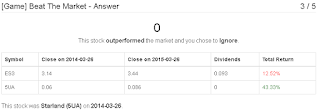Here's how it will look like: https://www.sgxcafe.com/user/profile?username=jarwey
I chose not to show the actual amount, but anybody who is smart enough can guess by looking at the total dividend and work backwards.
 |
| SGXCafe Profile Sharing Settings |
Benefit 2: Calculates total return for your portfolio. You can create different portfolios to calculate this return differently if you are managing different accounts for your family members.
Benefit 3: Easy to share the portfolio to friends who ask you what you have bought. Particularly useful when you have so many shares that you can't remember every single one within 5 seconds.
Frill: A game that you can play to practise your skill at evaluating stocks. To be honest, this is probably not suitable for newbies because it doesn't teach you how to evaluate. It shows a bunch of financial ratios and you decide whether to buy or not. As the game removed the company name, the business is unknown to you, but you can see how well/badly the company performed compared with similar businesses (in the same industry). Here's how the scoring is done:
Although the creator asked for feedback to share how we (the players who had played the game) evaluate the numbers, I find it hard to explain what goes through my mind. One thing I know for sure is I always avoid companies making losses. Out of all the loss-making companies I chose to ignore, I only recall 1 or 2 companies that outperformed, which is probably the most a 5%. I am ok to forego that 5% companies for now, but I haven't given up trying to identify what indicators will point to the outperform possibility.




